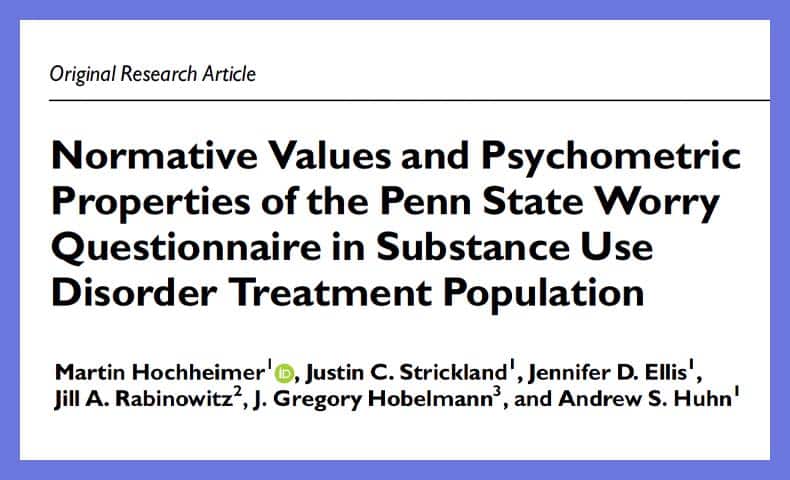Original Research Article
Normative Values and Psychometric Properties of the Penn State Worry Questionnaire in Substance Use Disorder Treatment Population
Martin Hochheimer¹, Justin C. Strickland¹, Jennifer D. Ellis¹, Jill A. Rabinowitz², J. Gregory Hobelmann³, and Andrew S. Huhn¹
Abstract
This study evaluated the Penn StateWorry Questionnaire (PSWQ) as a tool for measuring worry and anxiety levels among individuals entering treatment for substance use disorders (SUDs). The sample included 75,047 individuals admitted to SUD treatment centers, with assessments conducted weekly. Individuals entering SUD treatment exhibited higher baseline levels of worry; however, worry levels declined over the course of treatment. The PSWQ demonstrated good internal consistency, high test-retest reliability, and good discriminant validity when correlated with measures of depression and stress. The factor structure analysis confirmed that the PSWQ measures the same underlying construct of worry in the SUD treatment population, with a single-factor model showing satisfactory fit. This extends the reach of the PSWQ to the SUD treatment population by reaffirming its reliability, validity, and factor structure, with the expectation of higher levels of worry compared to a non-SUD population at the beginning of treatment, which decline over time.
Keywords
substance use disorder, anxiety, Penn StateWorry Questionnaire, psychometric properties, treatment population
Introduction
For individuals with substance use disorders (SUDs), continued drug and/or alcohol use is driven, in part, by a desire to relieve negative affective states associated with abstinence (Koob, 2015). Co-occurring mental health conditions, such as anxiety disorders, are common among persons with SUDs. Treating these conditions during SUD treatment can be challenging, as it is often difficult to distinguish between pre-existing or cooccurring mental health conditions and symptoms that arise as a direct consequence of long-term substance use. The presence of mental health symptoms at SUD treatment intake and their trajectory during treatment have been associated with treatment attrition and relapse (Boschloo et al., 2012; Ellis et al., 2022; Rabinowitz et al., 2023); yet, there is limited information regarding normative values for scales that measure mental health symptoms, such as anxiety, among individuals with SUD, which could help clinicians benchmark individuals as they enter and participate in SUD treatment.
¹Johns Hopkins University School of Medicine, Baltimore, MD, USA
²Department of Psychiatry, Robert Wood Johnson Medical School, Rutgers University, Piscataway, NJ, USA
³Ashley Addiction Treatment, Havre de Grace, MD, USA
Click here to download the complete article in PDF format


